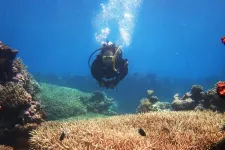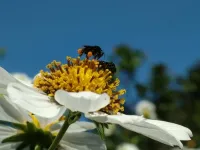(Press-News.org) The use of mobile technologies to collect and analyze individuals’ location information has produced massive amounts of consumer location data, giving rise to an elaborate multi-billion-dollar system in which consumers can share personal data in exchange for economic benefits. But privacy risks prevail.
In a new study, researchers used machine learning to create and test a framework that quantifies personalized privacy risks; performs personalized data obfuscation; and accommodates a variety of risks, utilities, and acceptable levels of risk-utility tradeoff. The framework outperformed prior models, significantly reducing consumers’ privacy risk while preserving advertisers’ utility.
The study was conducted by researchers at Carnegie Mellon University (CMU), the University of Virginia, and New York University. It is published in Information Systems Research.
“The global market for location analytics alone is projected to reach $25.5 billion by 2027,” notes Beibei Li, associate professor of IT and management at CMU’s Heinz College, who coauthored the study. “As industries increasingly unleash the power of location big data, our study offers a much-needed framework to balance privacy risks and data utilities, and to sustain a secure and self-governing multi-billion-dollar location ecosystem.”
Massive volumes of mobile location data are being generated daily through smartphone location-based services (e.g., navigation, ride share, food delivery services). Such data track consumers’ behavior—where they eat and shop, what products they buy—to enable applications of commercial value (e.g., restaurant recommendations, location-based advertising, market research). Advertisers, who gain access to location data through data aggregators, can predict consumers’ next location with 25% success and next activity and timing with 26% success.
But there are considerable risks to consumers of sharing location data, which includes personally identifiable information like names and home addresses. Some advertisers may carry out malicious acts using the data, usually for short-term revenue gains. Therefore, data aggregators need a personalized and flexible framework to balance diverse types of risks and utilities for different kinds of consumers and advertisers.
In this study, researchers developed a machine learning-based framework that quantifies individual consumers’ privacy risk, quantifies advertisers’ utility, and features a personalized and flexible obfuscation scheme. The scheme suppresses a subset of locations visited by a consumer based on his or her personalized suppression parameter proportional to the individual’s risk level; it also accommodates different types and different acceptable levels of risks and utilities.
To test their framework, researchers partnered with a leading data aggregator that integrates location data across more than 400 commonly used mobile apps (e.g., news, weather, maps, fitness) from a quarter of the U.S. population who are in compliance with privacy regulations. The data, collected in five weeks from September to October 2018, are representative of the U.S. population and the sample analyzed covers a major U.S. metropolitan area. Researchers validated the framework on a million trajectories (where and when consumers move) generated by 40,000 consumers in a major U.S. metropolitan area.
The study’s framework accounts for distinct characteristics of individual-level location data, and outperforms multiple benchmark methods from recent studies, according to the authors.
Using the proposed framework, the authors say, a data aggregator can effectively curtail a potential invasion of consumer privacy by performing personalized data obfuscation without sacrificing the utility of the obfuscated data to an advertiser. The aggregator may also fulfill personalized and diverse demands from both consumers and advertisers by flexibly accommodating multiple types of risks and utilities, as well as a wide array of acceptable levels of a specific risk, utility, and risk-utility tradeoff.
“Location-based marketing is rapidly becoming a primary venue for planning marketing campaigns and targeting consumers, enriching both traditional and digital marketing strategies,” explains Meghanath Macha, a graduate of CMU’s Heinz College, who led the study. “Our framework fills a critical void and offers an important tool for the privacy-aware practices of big data location-based applications and services, providing a balance between privacy risks and data utilities.”
Among the study’s limitations, the authors note that the data they used contain no information about individual consumers’ demographics, which would allow greater understanding of privacy issues. In addition, their proposed framework considered only one-shot data sharing with an advertiser; it did not consider more complex scenarios with multiple risks or utilities, or what happens when an advertiser combines multiple batches or sources of shared data.
END
Amid volumes of mobile location data, new framework reduces consumers’ privacy risk, preserves advertisers’ utility
2023-06-05
ELSE PRESS RELEASES FROM THIS DATE:
Early universe crackled with bursts of star formation, Webb shows
2023-06-05
Among the most fundamental questions in astronomy is: How did the first stars and galaxies form? NASA’s James Webb Space Telescope is already providing new insights into this question. One of the largest programs in Webb’s first year of science is the JWST Advanced Deep Extragalactic Survey, or JADES, which will devote about 32 days of telescope time to uncover and characterize faint, distant galaxies. While the data is still coming in, JADES already has discovered hundreds of galaxies that existed when the universe was less than 600 million years old. The team also has identified galaxies sparkling with a multitude of young, hot ...
NASA’s Webb Space Telescope peers behind bars
2023-06-05
A delicate tracery of dust and bright star clusters threads across this image from the James Webb Space Telescope. The bright tendrils of gas and stars belong to the barred spiral galaxy NGC 5068, whose bright central bar is visible in the upper left of this image – a composite from two of Webb’s instruments. NASA Administrator Bill Nelson revealed the image Friday during an event with students at the Copernicus Science Centre in Warsaw, Poland.
NGC 5068 lies around 20 million light-years from Earth in the constellation Virgo. This image of the central, bright star-forming regions ...
New digital tool enables farmer’s decisions for sustainable agriculture
2023-06-05
A new ‘digital decision support tool’ enabling the transition towards more diversified and sustainable agricultural systems has been developed by an international team of researchers from Germany, France, and Czech Republic.
The research led by Dr Ioanna Mouratiadou from the Leibniz Centre for Agricultural Landscape Research, and published in Environmental Science and Ecotechnology, presents the ‘Digital Agricultural Knowledge and Information System (DAKIS)’ as a data integration ...
CRISPR/Cas9 reveals a key gene involved in the evolution of coral skeleton formation
2023-06-05
Baltimore, MD—New work led by Carnegie’s Phillip Cleves uses cutting-edge CRISPR/Cas9 genome editing tools to reveal a gene that’s critical to stony corals’ ability to build their reef architectures. It is published in Proceedings of the National Academy of Sciences.
Stony corals are marine invertebrates that build large skeletons, which form the basis of reef ecosystems. These biodiversity hotspots are home to about a quarter of known marine species.
“Coral reefs have ...
Human factors affect bees’ communication, researchers find
2023-06-05
Human influences have the potential to reduce the effectivity of communication in bees adding further stress to struggling colonies, according to new analysis.
Scientists at the University of Bristol studying honeybees, bumblebees and stingless bees found that variation in communication strategies are explained by differences in the habitats that bees inhabit and differences in the social lifestyle such colony size and nesting habits.
The findings, published today in PNAS, reveal that anthropogenic change, such as habitat conversion, climate change and the use of agrochemicals, are altering the world bees occupy, and it is becoming increasingly clearer that this affects communication ...
Coaxing hair growth in aging hair follicle stem cells
2023-06-05
· Regulating cell mechanics stimulates hair growth in mice
· Next step will be testing if delivering microRNA via nanoparticles grows hair
· Potential for human hair growth
CHICAGO --- Just as people’s joints can get stiff as they age and make it harder for them to move around, hair follicle stem cells also get stiff, making it harder for them to grow hair, reports a new Northwestern Medicine study.
But if the hair follicle’s stem cells are softened, ...
Cure Mito Foundation launches resource on Leigh syndrome
2023-06-05
McKinney, TX., June 5, 2023 - The Cure Mito Foundation, a parent-led organization dedicated to advancing research and treatments for Leigh syndrome, has launched the first-of-its-kind online resource about Leigh syndrome, the most common type of pediatric mitochondrial disease.
The free resource, “About Leigh Syndrome” (https://www.aboutleighsyndrome.com), serves as a central place where patients, caregivers and doctors can find information on Leigh syndrome, including its symptoms, diagnosis, treatment options, and more. Translation ...
Tools to assess crime risk for young cohorts are likely to fail over time if they ignore social change
2023-06-05
Risk assessment instruments (RAIs) are widely used to inform high-stakes decision making in the criminal justice system and other areas, such as health care and child welfare. These tools typically assume a relation between predictors and outcomes that does not vary with time. But because societies change, this assumption may not hold in all settings, generating what a new study calls cohort bias—a bias resulting from cohort-wide influences not experienced by past or future cohorts.
The study, by researchers ...
Direct air capture technology licensed to Knoxville-based Holocene
2023-06-05
An innovative and sustainable chemistry developed at the Department of Energy’s Oak Ridge National Laboratory for capturing carbon dioxide from air has been licensed to Holocene, a Knoxville-based startup focused on designing and building plants that remove carbon dioxide from atmospheric air.
“ORNL is tackling climate change by developing numerous technologies that reduce or eliminate emissions,” said Susan Hubbard, ORNL deputy for science and technology. “But with billions ...
Fetal exposure to PCBs affects hearing health later in life
2023-06-05
Music, mice, and microscopic imaging combine to provide new insight into the effects of environmental chemicals on hearing loss.
Researchers at the Beckman Institute for Advanced Science and Technology found that early exposure to an environmental chemical called polychlorinated biphenyls, or PCBs, made it more difficult for mice to recover from sound-related trauma sustained later in life.
Their paper appears in the Journal of Neuroscience.
PCBs are carcinogenic compounds formerly used in industrial and consumer products. Although they were banned in the United States in 1979 and haven’t seen industrial use in decades, their highly ...





